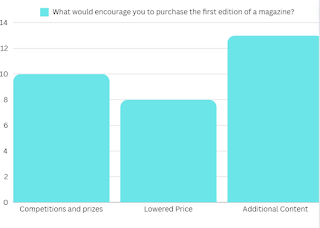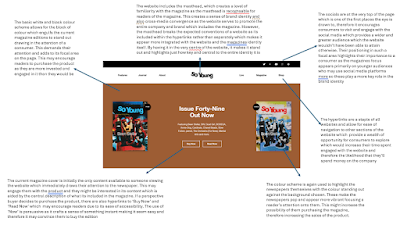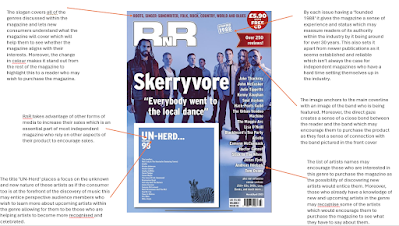I conducted research into the interests in both music and music magazines of 16-25 with 18 people surveyed with the majority being 16-18 with only 4 18-21 and 3 21-25 which, while on a limited scale, allows for me to see the interests and desires of my target audience. The survey spanned from primary music interests and how they access music to wishes for a new music magazine and features that would interest them in a subscription. This helps to influence my production of many aspects of my independant music magazine as I am able to understand the interests of my target audience to best manufacture my product to them.
It's clear that the most popular genre of music is Pop with 33.3% of answers being this genre. It's important to note that participants were able to select multiple genres of interest and while 13/18 participants identified pop as one of their favourite music genres, they also have other interests. Not only is pop very popular in the younger demographic, but rock and indie/alternative music also has a clear audience that may be able to be specifically targeted through a product. While it's evident there's a large market for a Pop magazine, it's key to understand that magazines can be crafted to target a specific demographic depending on their interests so having an interest in rock, metal and indie allows for a market to promote a magazine to.

The favoured genres is again reflected in the genres which participants would want to see in a new music magazine. There's clearly a large interest in pop music magazines, if they were to purchase a new magazine but 21.4% would be engaged by a rock/metal or indie magazine if it were to be produced. Both of these results help to influence my previous knowledge of the interests of my demographic and allow for a greater understanding into the desires of those who my magazine would be directly targeted towards.

The survey also enabled me to gain a greater understanding of how to engineer my product to capture the interests of my target demographic. By accumulating data into the extra additions which would interest them to purchase the first edition of a new music magazine or a subscription service as well as the pricing to make the magazine appealing.
The majority of participants (13) were willing to pay £5 or more for a music magazine which is a reasonable price that not only allows to compete effectively with the competition but also to attract enough consumers to maintain a profit. The prices they would pay for a magazine reflects the fact that a large amount of the demographic will still be in education and therefore may not have the ability to spend a great amount of their money on such a product and so this leads them to prefer a lower, yet still reasonable price for a magazine.
This idea of price as a key point of interest when looking at how to best market the product to my target audience becomes more apparent through the 8 participants who said that a lowered price for the first edition would encourage them to purchase the magazine. This allows for them to see the content offered by the magazine without paying the full price and may influence them to continue purchasing the magazine if it interests them. The results also showed the influence of additional content such as CDs and Posters to provide an extra incentive for consumers to purchase the magazine, again to hook them in order to gain a larger long-term audience. Concert tickets and competitions also appeared to be a useful incentive as many participants attended concerts/gigs so the opportunity to win tickets to these events would be another way to increase the number of readers for the first edition.
Another feature which most, if not all, independent music magazines utilise is a subscription service. These allow for an additional method of gaining profit apart from physical sales and advertisement as so for magazines without funding they're useful in order to maximise the profit created. Therefore, I made sure to understand what would encourage consumers to subscribe to a magazine. There seems to be quite a wide variety of ways in order to entice readers to subscribe to the magazine but the inclusion of additional content (especially posters) seems to be a great incentive for this type of service. A direct delivery also appeared to be a popular ammenity as it allows an ease of attaining the product, whereas it may be unlikely for consumers to often find themselves in a location where they're able to purchase a magazine which would dimish the sales of the product.

I also believed it to be essential to understand the type of content which would interest consumers of the demographic to hopefully engage them and convince them to purchase the magazine. In order to effectively carry this out I looked into the ways participants access music, their interests in concerts and how they access news regarding music. 100% of participants used streaming services with only 3 using other physical forms on occassion to listen to music and therefore it allows me to understand how to best promote these types of services to try and engage and interests audiences rather than attempting to create content based on other forms which wouldn't resonate with an audience. Moreover, the results show a clear interest in concert and gigs and even those who don't attend any are likely to only do so due to an inability to attend such events. Therefore, this shows a clear desire for content regarding such events so a section or coverlines dedicated to these would help to gain a greater audience interest in the magazine. Furthermore, all 18 participants use social media in order to access their music news so by crafting my magazine to be somewhat similar in style to the format of these sources it may help to maintain engagement for these audiences and allow a greater number of consumers for my product.

























